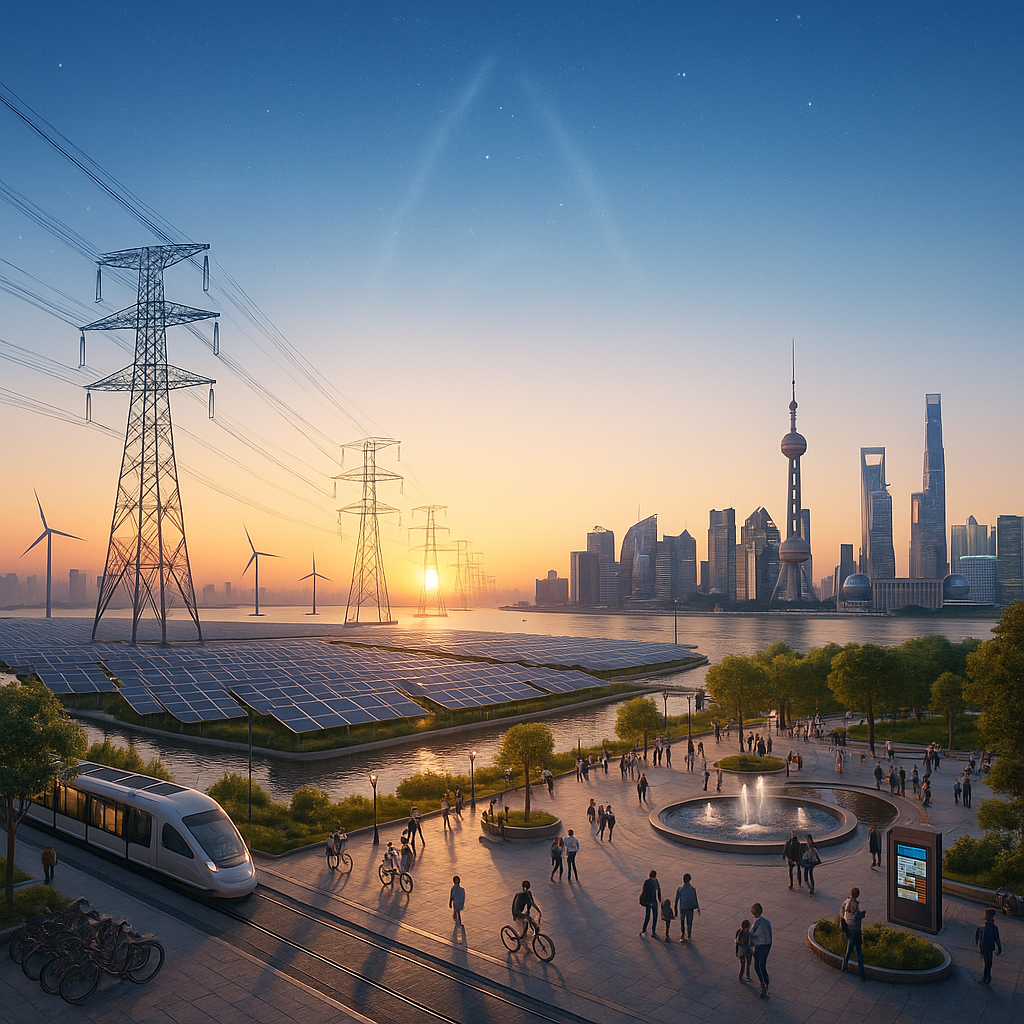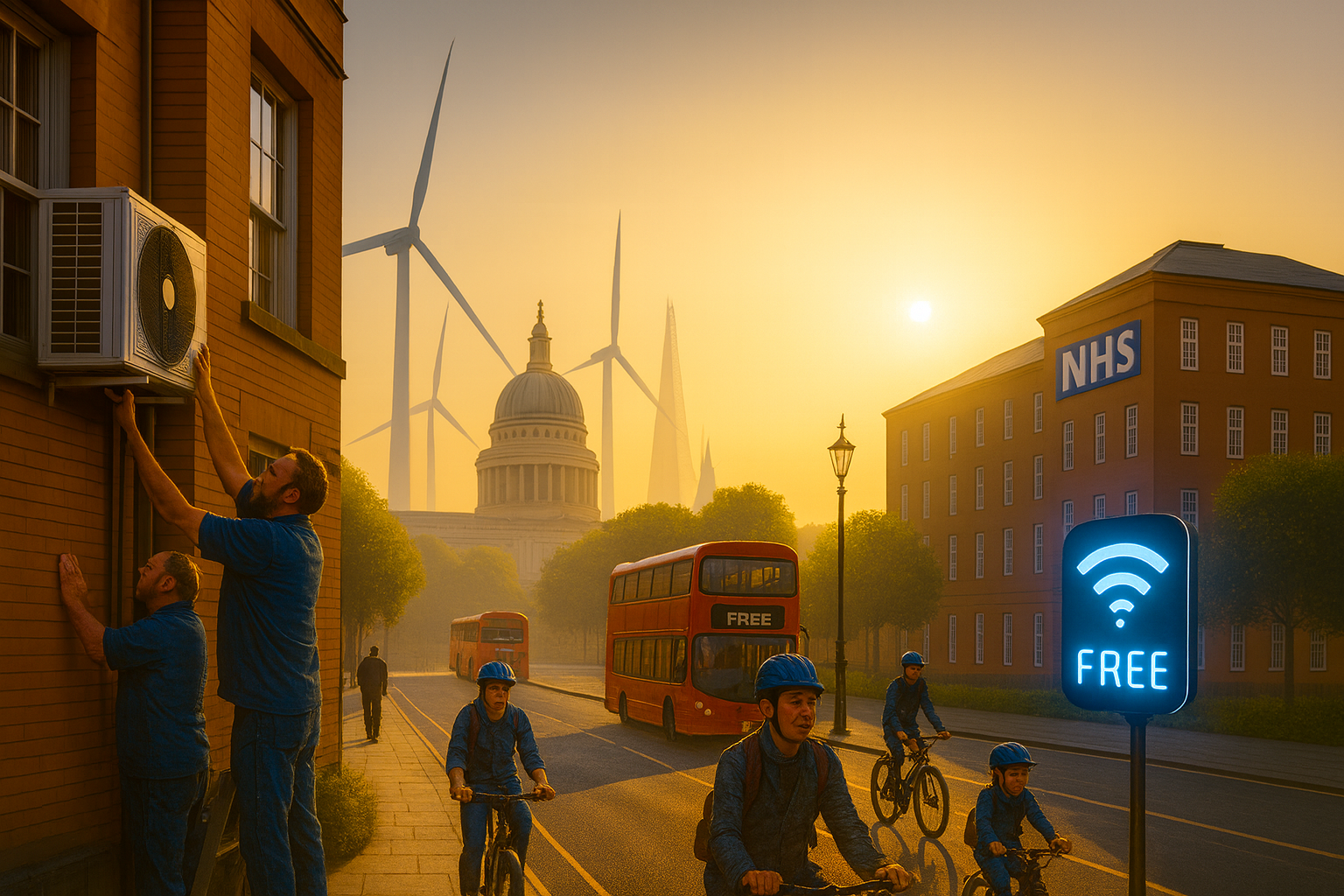To Boldly Grow: How to Get from Here to Star Trek — Thanks to Electrotech

Not phasers or warp drive, just a world where life is free. When energy is too cheap to meter and the basics of life run as modern commons money will quietly stop gatekeeping dignity. A new electrotech report shows how fast free power is arriving. Let map out the rest of the revolution.
In the StarTrek universe money has faded into the background. We can have that too - and sooner than you'd think. Most of what matters, moving, staying warm, getting care, learning, connecting can happen without a checkout. The most convincing evidence that this direction of travel is real comes from **Ember’s **The Electrotech Revolution, a superb, graph‑rich report showing how solar, batteries, EVs, heat pumps and smart grids are driving the marginal cost of clean power down. It turns out the sun and shunted electrons are our dilithum crystals.
The next step is to pivot from electrons to everyday life. The challenge is governance: how to build a NHS‑style commons—free transport, free care, free connectivity, and a public baseline of heat and power—so the turnstiles vanish, the card machine disappears, and dignity no longer depends on a bank balance. Let's make it so.
Part I — Do Look Up: the glowing abundance we keep forgetting to notice
Picture an ordinary weekday in 2027 London. Rooftops sparkle with PV; buses glide rather than growl; a cabinet‑sized battery in a nearby substation drinks in cheap midday power for this evening’s kettles; your neighbour’s heat pump does quiet alchemy—one unit of electricity in, three to five units of warmth out. None of this feels sci‑fi anymore. It’s just… working. To be fair, London is actually a bit of a laggard here. The real revolution is happening in China and Africa.
If you want the single best explainer of what is happening, read Ember’s graph‑rich brief and slide deck, “The Electrotech Revolution.” They show how five gears—solar, batteries, electric vehicles, heat pumps, and smart grids—mesh into one drivetrain that changes the physics of daily life. As the report says, in FIVE days the suns hits us with the same energy as ALL of our remaining fossil fuel reserves.
Seriously, go and read the Ember deck right now - it is not a flimsy broadsheet thinkpiece, it's an intense but optimistic picture of exactly where we are now. With TONS of real data.
This is just the tl;dr.
Solar is no longer a sideshow: in June 2025 solar provided 22.1% of all EU electricity (45.4 TWh), the single largest source that month. That wasn’t a model; it happened across a continent, during a heatwave (Ember with coverage by Reuters). Storage is racing to match: the United States passed 26 GW of utility‑scale batteries in 2024, adding around 10 GW in a single year (U.S. Energy Information Administration). EVs are becoming part of the grid rather than a problem for it; the IEA’s Global EV Outlook 2025 shows their electricity demand is already meaningful and controllable with smart charging—exactly the kind of flexible load that soaks up noon‑solar and eases the evening peak (IEA). Heat pumps do old‑fashioned thermodynamics with modern finesse: seasonal performance of 3–5 units of heat per 1 unit of electricity (IEA explainer).

In figure 1 you can see how much thing have changed in just 15 years. The lines go up but don’t read them so much as feel them. In one glance you can sense how the story has changed: supply doesn’t creep, it surges; the connective tissue of batteries and long‑distance wires turns noon sunshine into midnight light; and demand itself learns new tricks as wheels and heaters run on electrons. The thrill isn’t any single up‑swoop but their synchrony—generation, connection, and use accelerating together like gears that finally mesh. That’s the moment scarcity starts to look old‑fashioned and planning becomes the art of timing.

Step back and you see a pattern: the marginal cost of electricity keeps sliding toward near‑zero at certain hours, and our systems are learning to move energy in time (batteries, demand response, smart tariffs) as well as in space (interconnectors). That’s the engineering definition of abundance: not infinite energy, but reliable, clean, low‑marginal‑cost power when you need it.

What's more electrical energy use is 2-4x more efficient than hydrocarbons. Feed a kilowatt‑hour to an electric motor and around 90% of it becomes motion; pour the same energy into a combustion engine and most of it escapes as heat. At home it’s the same story: move electrons with a heat pump and one unit of electricity becomes three to five units of warmth. Move electrons, not molecules, and you do more with less—fewer imports, fewer leaks, less noise, lower bills. That efficiency dividend is what bends the curves; electrification isn’t merely cleaner, it’s fundamentally leaner.

Look east and south for acceleration. China is industrialising the electrotech stack at planetary scale. In the three years to 2024, China more than doubled wind + solar capacity—from roughly 635 GW to over 1,400 GW—pushing wind+solar towards about 18% of national generation, while seeding global learning curves that drive costs down for everyone (Ember, China Energy Transition Review 2025 · PDF). Across Africa, mini‑grids and distributed solar‑battery systems are spreading because they beat diesel on reliability and total cost where the legacy grid doesn’t reach (World Bank). The point isn’t that energy is free everywhere. It’s that the physics and the factories now favour abundance if we complete the job on storage and flexibility
Seriously, read the report. It's mostly pictures! And mostly good news! Ember’s big contribution is synthesis: they knit the facts into a usable story. We’ll clip a handful of their key charts in the published version so readers can see the curve turning—solar’s June surge, battery buildouts, EV smart‑charge potential, heat‑pump multipliers.

Part II — Make It So: NHS‑style Commons (turn cheap electrons into cheap living)
Now change scenes. You wake up ill, you go to the NHS, and you’re treated free at the point of use. No app gate. No card machine. That’s not charity; it’s infrastructure. It's been done before and can be done more. The simple, radical proposal is to treat more essentials in an NHS‑style: baseline transport that just works without fares; childcare and eldercare centres as routine as schools; basic broadband like tap water; and a public energy allowance—some kilowatt‑hours and heat each day at zero price, firmed by storage and smart demand. Every time we convert a life‑need from a private bill to shared infrastructure, money stops being the gatekeeper.
“Can we afford it?” is the wrong question. As Modern Monetary Theory keeps pointing out—and as Brett Scott explains crisply in the article that sparked this essay—currency‑issuing governments don’t find money; they issue it. The real constraints are people, kit, and ecological headroom, with inflation as the binding signal. Spend to mobilise idle capacity; tax and regulate to steer demand; judge success by care delivered, homes insulated, buses run—not by a mythical household ledger. If you haven’t read it yet, Scott’s primer is a great map of both the plumbing and the narrative: “Modern Monetary Theory (MMT): A Primer” (Asomo/Scott).
There’s also a humane engine that makes this bite immediately: a Job Guarantee plus Universal Basic Services. If you want work, there is useful, local, properly paid work—retrofitting homes, restoring nature, childcare, community arts and sport. That ends the waste of involuntary unemployment and accelerates the very projects abundance needs. In parallel, expand the NHS‑style domains where you don’t face a checkout. The two reinforce each other: the more we rely on commons, the less your day‑to‑day dignity depends on chasing cash.
We’re not guessing. Universal Basic Income pilots in Finland and Canada found that people didn’t down tools; they used breathing space to retrain, start micro‑businesses and live healthier lives. Mutual credit networks like Sardex kept small firms trading when cash was tight. Time banks let neighbours swap tutoring for gardening with no money at all. During COVID, governments literally paid millions to stay home—a blunt reminder that, in a real emergency, we can choose provisioning over paperwork. After World War II, Britain built the NHS from scratch. The rules have changed before; they can change again.
Why isn’t this already front and centre?
Because money stories are power—and much of the West is still peering through the smog of oil. The “government as household” cliché props up scarcity politics and protects incumbents who profit from billing people for essentials—banks, private insurers, fossil fuel interests. That façade is starting to crack. The UK Green Party’s new leader Zack Polanski has been saying the quiet part out loud:
“We need to destroy this really bad metaphor that the household budget is anything like a national economy.” — Zack Polanski (see clip via Best for Britain and Economics for the Many).
Polanski has also floated ending Bank of England interest payments on commercial bank reserves and using the savings for public services—one example of “changing the plumbing” to fund commons (Financial Times coverage). Meanwhile, we—as humanity—are already moving: China is mass‑manufacturing the electrotech stack; African nations are scaling solar mini‑grids because they beat diesel on cost and reliability. The technology runway is here; the political fog is local.
From here to there — the green recipe to erase money
Phase 1 — Flip the money story (0–5 years). Tell the truth in public: governments don’t run out of pounds; they run out of nurses, installers and grid capacity. Launch Job Guarantee pilots via councils and community organisations. Start the NHS‑style expansion where electrotech makes it easiest: free city transport on clean power, baseline broadband, and a public energy allowance at zero price during surplus hours.
Phase 2 — Build the commons (5–15 years). Turn essentials into shared infrastructure: universal childcare and eldercare; mass home retrofits and heat‑pump rollout; interconnectors, neighbourhood batteries and EV smart‑charging by default. The result is a city where zero‑price basics feel as normal as streetlights.
Phase 3 — Live beyond the wallet (15+ years). Money doesn’t vanish; it just stops deciding your dignity. Markets remain for luxuries and true scarcities; status shifts toward creativity, discovery and care. Daily life feels freer because you’re no longer budgeting for entry to society.
Electrotech gives us the power; a modern commons could give that power purpose. We can choose beneficence over bean-counting and make dignity default.
Live long and prosper. 🖖
Copyleft, Caspar Addyman 2025
Written with frustrating assistance of GPT-5.
Sources
- Ember — “The Electrotech Revolution”: overview article · slide deck PDF
- Ember — Solar tops EU power mix (June 2025): analysis · coverage Reuters
- U.S. Energy Information Administration — Utility‑scale battery storage passed 26 GW in 2024: Today in Energy
- International Energy Agency (IEA) — Global EV Outlook 2025: report
- IEA — The Future of Heat Pumps (how a heat pump works): explainer
- Ember — China Energy Transition Review 2025: summary · PDF
- World Bank / SEforALL — Mini‑grids for universal energy access: press · SEforALL brief
- Brett Scott — “Modern Monetary Theory (MMT): A Primer” (inspiration for Part II): Asomo/Scott
- Zack Polanski — household‑budget metaphor critique: clip 1 · clip 2 · BoE reserves proposal: Financial Times
